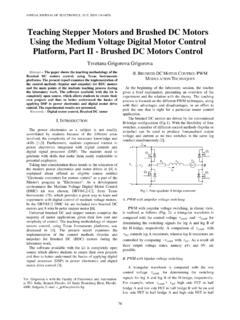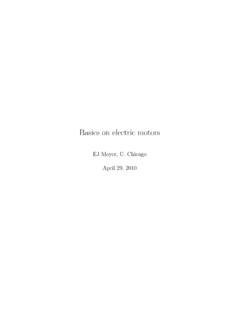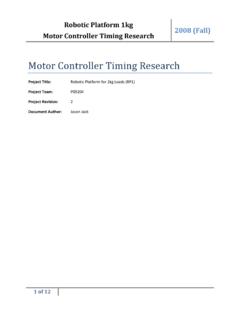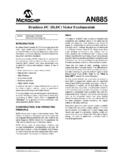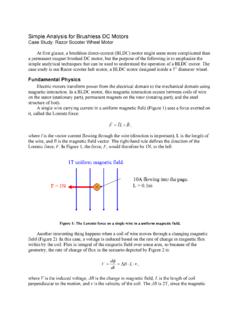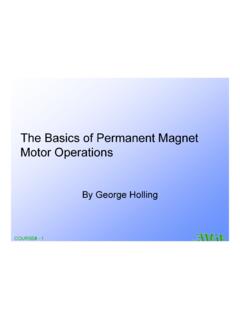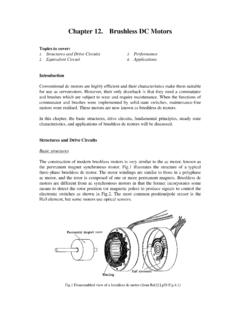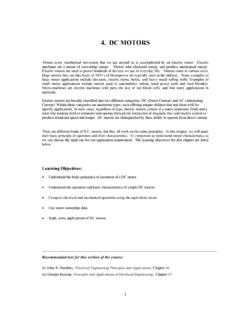Transcription of Brushed DC Motor Fundamentals - Digchip
1 AN905. Brushed DC Motor Fundamentals Author: Reston Condit Stator Microchip Technology Inc. The stator generates a stationary magnetic field that surrounds the rotor. This field is generated by either permanent magnets or electromagnetic windings. The INTRODUCTION different types of BDC motors are distinguished by the construction of the stator or the way the electromag- Brushed DC motors are widely used in applications netic windings are connected to the power source. ranging from toys to push-button adjustable car seats. (See Types of Stepping Motors for the different BDC. Brushed DC (BDC) motors are inexpensive, easy to Motor types). drive, and are readily available in all sizes and shapes.
2 This application note will discuss how a BDC Motor works, how to drive a BDC Motor , and how a drive Rotor circuit can be interfaced to a PIC microcontroller. The rotor, also called the armature, is made up of one or more windings. When these windings are energized PRINCIPLES OF OPERATION they produce a magnetic field. The magnetic poles of this rotor field will be attracted to the opposite poles The construction of a simple BDC Motor is shown in generated by the stator, causing the rotor to turn. As the Figure 1. All BDC motors are made of the same basic Motor turns, the windings are constantly being components: a stator, rotor, brushes and a commutator. energized in a different sequence so that the magnetic The following paragraphs will explain each component poles generated by the rotor do not overrun the poles in greater detail.
3 Generated in the stator. This switching of the field in the rotor windings is called commutation. FIGURE 1: SIMPLE TWO-POLE Brushed DC Motor . N. NORTH. SOUTH. Brushes Commutator Field Magnet Axle Armature or Coil 2004 Microchip Technology Inc. DS00905A-page 1. AN905. Brushes and Commutator Shunt-Wound Unlike other electric Motor types ( , brushless DC, Shunt-wound Brushed DC (SHWDC) motors have the AC induction), BDC motors do not require a controller field coil in parallel (shunt) with the armature. The to switch current in the Motor windings. Instead, the current in the field coil and the armature are indepen- commutation of the windings of a BDC Motor is done dent of one another.
4 As a result, these motors have mechanically. A segmented copper sleeve, called a excellent speed control. SHWDC motors are typically commutator, resides on the axle of a BDC Motor . As the used applications that require five or more horsepower. Motor turns, carbon brushes slide over the commutator, Loss of magnetism is not an issue in SHWDC motors coming in contact with different segments of the so they are generally more robust than PMDC motors. commutator. The segments are attached to different rotor windings, therefore, a dynamic magnetic field is FIGURE 3: SHUNT-WOUND DC. generated inside the Motor when a voltage is applied MOTORS. across the brushes of the Motor . It is important to note that the brushes and commutator are the parts of a BDC Motor that are most prone to wear because they Brush are sliding past each other.
5 DC Shunt Voltage Field Supply TYPES OF STEPPING MOTORS. Armature As mentioned earlier, the way the stationary magnetic field is produced in the stator differentiates the various types of BDC motors. This section will discuss the different types of BDC motors and the advantages/ Series-Wound disadvantages of each. Series-wound Brushed DC (SWDC) motors have the field coil in series with the armature. These motors are Permanent Magnet ideally suited for high-torque applications because the current in both the stator and armature increases under Permanent Magnet Brushed DC (PMDC) motors are load. A drawback to SWDC motors is that they do not the most common BDC motors found in the world.
6 Have precise speed control like PMDC and SHWDC. These motors use permanent magnets to produce the motors have. stator field. PMDC motors are generally used in appli- cations involving fractional horsepower because it is more cost effective to use permanent magnets than FIGURE 4: SERIES-WOUND DC. wound stators. The drawback of PMDC motors is that MOTORS. the magnets lose their magnetic properties over time. Some PMDC motors have windings built into them to Series prevent this from happening. The performance curve Field (voltage vs. speed), is very linear for PMDC motors. DC. Current draw also varies linearly with torque. These Voltage Armature motors respond to changes in voltage very quickly Supply because the stator field is always constant.
7 Brush FIGURE 2: PERMANENT MAGNET DC. MOTORS. Armature Brush DC. Voltage Supply Permanent Magnet Poles DS00905A-page 2 2004 Microchip Technology Inc. AN905. Compound-Wound Note that in each circuit there is a diode across the Motor . This diode is there to prevent Back Electromag- Compound Wound (CWDC) motors are a combination netic Flux (BEMF) voltage from harming the MOSFET. of shunt-wound and series-wound motors. As shown in BEMF is generated when the Motor is spinning. When Figure 5, CWDC motors employ both a series and a the MOSFET is turned off, the winding in the Motor is shunt field. The performance of a CWDC Motor is a still charged at this point and will produce reverse combination of SWDC and SHWDC motors.
8 CWDC current flow. D1 must be rated appropriately so that it motors have higher torque than a SHWDC Motor while will dissipate this current. offering better speed control than SWDC Motor . FIGURE 6: LOW-SIDE BDC Motor . FIGURE 5: COMPOUND-WOUND DC DRIVE CIRCUIT. MOTORS. VCC. Series Field Brush DC. D1. Voltage Shunt BDC. Supply Field Motor Armature To Controller R1. BASIC DRIVE CIRCUITS. Drive circuits are used in applications where a control- R2. ler of some kind is being used and speed control is required. The purpose of a drive circuit is to give the controller a way to vary the current in the windings of the BDC Motor . The drive circuits discussed in this section allow the controller to pulse width modulate the voltage supplied to a BDC Motor .
9 In terms of power FIGURE 7: HIGH-SIDE BDC Motor . consumption, this method of speed control is a far more DRIVE CIRCUIT. efficient way to vary the speed of a BDC Motor compared to traditional analog control methods. VCC. Traditional analog control required the addition of an inefficient variable resistance in series with the Motor . To Controller VCC. R2. BDC motors are driven in a variety of ways. In some cases the Motor only needs to spin in one direction. Figure 6 and Figure 7 show circuits for driving a BDC R1. Motor in one direction. The first is a low-side drive and the second is a high-side drive. The advantage to using the low-side drive is that a FET driver is not typically needed.
10 A FET driver is used to: D1. 1. bring the TTL signal driving a MOSFET to the BDC. Motor potential level of the supply voltage, 2. provide enough current to drive the MOSFET(1), 3. and provide level shifting in half-bridge applications. Note 1: The second point typically does not apply Resistors R1 and R2 in Figure 6 and Figure 7 are to most PICmicro microcontroller important to the operation of each circuit. R1 protects applications because PIC microcontroller the microcontroller from current spikes while R2. I/O pins can source 20 mA. ensures that Q1 is turned off when the input pin is tristated. 2004 Microchip Technology Inc. DS00905A-page 3. AN905. Bidirectional control of a BDC Motor requires a circuit Note the diodes across each of the MOSFETs (D1-D4).

